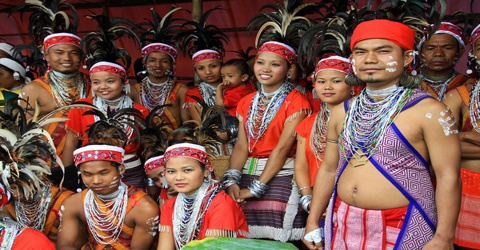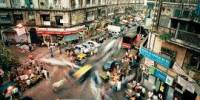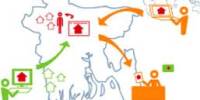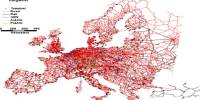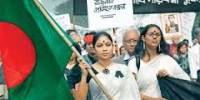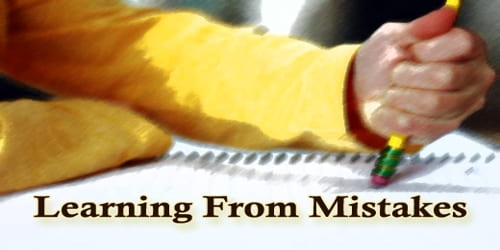Main observation of this thesis is to analysis Atlas of Language and Ethnic People of Bangladesh. Ethnic People will discover Maghs, Kukis, Chakmas, Lushais, Murangs, Tangchangys, Shendus, Bonjogis, Pankhos & others who dwell inside sylvan shadows of Chittagong Slope Tracts, the Khasis involving Sylhet border & Jaintia Hillsides, the Manituris who live in the vicinity of Sylhet town, the Garos, Hajongs, Hodis, Palias and Baluis who inhabit the hilly expanseof Mymensingh and Tangail and this Oraons, Santals, Rajbansis, Hos, Mundas, Buns and the remainder who dwell on this plains of Rangpur, Dinajpur, Rajshahi and Bogra.
Introduction
Bangladesh is a land of variety. The charm of its land- scape, hills, hillocks& woods are as alluring as those of the primitive people who inhabit its solitary woodlands. There are Maghs, Kukis,Chakmas,Lushais,Murangs,Tangchangys,Shendus,Bonjogis,Pankhos,&Tipras& others who dwell in the sylvan shadows of Chittagong Hill Tracts, the Khasis of Sylhet border &Jaintia Hills, the Manituris who live in the vicinity of Sylhet town, theGaros,Hajongs,Hodis,Palias&Baluis who inhabit the hilly expanseof Mymensingh & Tangail,& the Oraons,Santals,Rajbansis ,Hos,Mundas ,Buns & the rest who dwell on the plains of Rangpur, Dinajpur,Rajshahi & Bogra.
In Chittagong Hill Tracts the Ethnic people are related to Arakan or Barma Kuki-Chine generation & some Ethinic people came from Southern part.The Anthropologist LAUIN are divided two main kinds of Ethinic people:
- Khiontha / Rivers child (They live in the river side area ).
- Tongtha / Hills child ( They live in Hill area ).
The Ethnic group of Bangladesh:
- ORAONS
- SANTALS / SAONTAL
- RAJBANSI
- KHASI / KHASIA
- MANIPURIS
- PANGONS
- GAROS / MANDI
- HAJONGS
- MAGHS
- MURANGS
- TIPRAS / TRIPURAS
- PANKHOS &BANJOGIS
- SHENDUS
- KHUMIS
- CHAKMAS
- LUSHAI
- BOMANG
- MARMA
- CHAK
- KHYANG
- KUKI
- BAWN
- BONGJOGI
- HARIZON
- MAHAT
- MRO
- MONG
- MUNDA / MUNDIA
- PAHARI / PHARIA
- PATHER
- URANG / ORAN
- URUO / URUA / URIN
- SHONDUJ
THE ORAONS
The Oraons are not the natives of the soil or autochthones, as it called of Bangladesh. They originally hailed from the hilly regions of Orissa,Chhoto Nagpur & Rajmahal of India. It is not known for certain when they migrated to Bangladesh. Some anti-Muslim historians state that they were expelled by the Muslim rulers of Mughal period from India and they took refuge in Bengal. They are coming from Australia.
SETTLED & POPULATION
A good number of Oraons have settled in RANGPUR, DINAJPUR, BOGRA & RAJSHAHI districts.
The Census Reports of 1872-1881 will clearly illustrate their distribution in the districts:
| Districts | 1872 A.D. | 1881A.D. |
| Rajshahi | 6,619 | 2,825 |
| Rangpur | 2,42 | 79 |
| Bogra | 1,67 | 4,22 |
| Pabna | 2,00 | 1,85 |
| Dhaka | 2 | 0 |
| Faridpur | 11 | 0 |
| Mymensing | 5 | 60 |
| Chittagong | 1 | 43 |
| Noakhali | 0 | 25 |
PHYSICAL STRUCTUR
In Anthropological classification the Oraons are to be placed under pre-Dravidian races.The pointers are their black complexion, flat nose, curly hair, round skull & medium height. These physical features, Sir H.H.Risley said, No signs of Mongolian affinities can be detected in the relative positions of the nasal & malar bones , & average nasa-malar index for a hundred oraons measured on the system recommended by Mr.Oldfieled Thomas Omens came to 113.6.”
CULTURE
They have some own culture. The Oraons reveal their cultural life is a clear & vivid outline. Many tribal pockets have been existing in Bangladesh from time immemorial. Their culture steams have even infiltrated into the Hindu society. The oraons observe this rite not only to have a child but also to raise farm production. I have already mentioned that some features of tribal culture have in filtrated into Hinduism. The Bhadu festival observed by the Hindu virgins of West Bengal is very much akin to Karam festival of the Oraons.Like the Karam or Kadam branches they place the figure of Bhadu goddess in their Puja-mandap and arrange songs & dances around the Bhadu.When the celebration is over they immerse the Bhadu through similar song & dance.
Child marriage, though approved by religion,is strongly discouraged, especially by the young generation. Unlike the Santals they have on forced marriage.Though more then one marriage is permissible, plurality of wives is not found. The dorwyfor the first marriage is Tk. 125, for the 2nd marriage Tk. 250 &for the 3rd marriage Tk. 500.
RELIGION
There religion are Muslim,Hindu,Bhadu….etc.I have already mentioned that some festures of tribal culture have in filtrated into Hinduism.The Bhadu festival obseroved by the Hindu virgins of West Bengal is very much akin to Karam festival of the Oraons.Like the Karam or Kadam branches they place the figure of Bhado goddess in their Puja-mandop & arrange songs & dances around the Bhadu.When the celebration is over they immerse the Bhadu through similar song & dance.
LANGUAGE
The Oraons speak Dravidian Oraon or Kurukh dialect. Below is reproduced a few words from the kurukh dialect.
| English | Kurukh | English | Kurukh |
| I | En | Hand | Hekha |
| We | Em | Leg | Khed |
| You | Nim | Nose | Moy |
| They | Aab | Mouth | Bhoi |
| My | Engai | Tooth | Pala |
The Oraons of Bangladesh are at present making rapid progeress. They are keen to spread education among themselves.
PROFESSION
They live on Jhum cultivation ,hunting. They hunt such as – fish, dog —– etc.
The Kurukh language admits some local variations. The oraon language as spoken in different districts of Bangladesh is a little different from what spoken in ranchi & chhota nagpur of India.
THE SANTALS/SOANTAL
The origin of the word Santal is commonly believed that their name has been derived from santal Pargana, the place of their principal settlement.But anthropologist like Skrefsrud is of the opinion that ‘Santal’ is derived from ‘soontar’ which is a title given by the Bengalees to a group of people.The people came from Australia.
SETTLED & POPULATION
The main pockets of their settlement in Bangladesh are Chapal Nawwabganj sub-division of Rajshahi district & Birol, Setabgang, Panchagarh & other locality of Dinajpur district.A few remnants of their settlement are also traceable in Rongpur & Bogra districts.Although the Santals were not enumerated under a separate head in the Census of 1961, the number of Santals in Bangladesh is by no means negligible. In 1931 the number of Santals in the areas which now comprise Bangladesh was 7,96,656. In 1941 the figure rose to 8,29,025. Hence their number rose by more than 32,000 in the course of a decade.In 1981 the number of Santals in areas which now comprise Bangladesh was estimated as follows:
| Districts | Population |
| khulna | 19 |
| Jessore | 55 |
| Rajshahi | 139 |
| Dinajpur | 6813 |
| Rangpur | 7 |
| Bogra | 252 |
| Pabna | 130 |
| Chittagng | 12 |
PHYSICAL STRUCTURE
In Bangladesh bear a close resemblance to the Burmese,Malyan & Chinese in facial feature. They are dark complexioned, flat nosed, thick-lipped, with curly hairs & medium height.
LANGUAGE
The main deity of the Santals is the sun.They say they have come from the land of Sun-rise.In their language are as follows:
- Hor means Man
- Hopen means The Children
- Thakur Jiu means The Spirit of God
| English terms | Santal terms | Santal terms for addressing them |
| Father | Baba | Eh ba |
| Mother | Ayo | Ayo |
| Uncle | Hudin Baba | Eh Hudin Baba |
| Aunt | Hudin Ayo | Eh Hudin Ayo |
CULTURE
They regained consciousness realized that they were man & woman. They also realized that they were unclothed.they were feeling prudish & embarrassed.They were appeared God Thakur Jir & taught them how to cloth themselvs.From now they learnt to cover their body.When a boy reaches the age of twenty or near about , he is marriet to 15 –16 years old girl.There are three types of Santals marriages.There are-
- Asli/DuarItut Sindur Bapla (Orthoedox marriage, or Prajapatya marriage of the Hindus).
- Raja-Raji (Love marriage).
- Hurkatara or Itut (Marriage by forcible application of vermion).
RELIGION
There religion are Bhadu,Chirstian, Hindu.They prayed to the Hill Gods(Marng Buru) or the great Mountain, “O Marang Buru,it is becoming very difficult to cross over the mountainous region.Please show us the path so that we can go over to another land & offer to our puja to You.”
PROFESSION
The santals are an agriculturl community. Both men & women work in the field.But the ploughing is done by men only as women can not tend animals efficiently.But women to perform the task of laying seeds & cropping.
The Santals are no exception & one is gratified to see them even more inclined towards education.The Santals believe in transmigration.They believe in svorog (Heaven),Norok (Hell).
THE RAJBANSIS
The aboriginal people of Bangladesh who claim to be the offshoots of Hindus,the Rajbansis are one.Though they have entered in to the faith of civilized religion like Hinduism at early stage,sediments of primal believe have still lasted in their unconseius mind & as a result they may be termed as primitive people.
SETTLED & POPULATION
The Rajbansis live in the plains of Mymesings,Rangpur, Dinajpur,Rajshahi & Bogra.During the Census of 1921.the total number of Rajbansis in undivided Bengle was 17,27,111 & In 1931 the number increased to 18,06,393.In Bangladesh during the Census of 1951 &1961 they have been included in the Hindu religion & as result the exact number of Rajbansis could not be gathered.But doubtless their number is increasing.
PROFESSION
They live on Agriculture, Fishing & Hunting.
LANGUAGE
The Rajbansis also speak corrupt Bengli.They have no script of written from of their language.For example –
- Jaya (to go)
- Khaya (to eat)
- Paya (to get)……etc
RELIGION
There religion are Hindu.In Rangpur they profess to be Vaishnabas,While In Darjeeling where ,Tantric ideas are perhaps more prevalent,their favourite goddes is arreged to be Kali,Bisahari or Manasa,Garami,Tistu Buri,Humunan,Bindur Tulsi or Rishi Kishto,Petham,Jogin,Hundum Deo,Bahato,Balbhadra Thakur & Kura Kuri are mentioned as among their minor gods.
CULTURE
In the house of the chief the nude women continue dancing & singing ,thus invoking raln.Then they move to other house one by one where the same rlte is repeated the male members having evacuated.Divoce &Re-marriage of widow have also been &adopted by the Rajbansi society. In case of re-marriage of a widow, her deseased husbund’s younger brother has the first claim. In this case they have to perform a special ceremony.
THE KHASI / KHASIA
A beautiful landscape with hills & dales, woods & streams & all the natural configurations has a tremendous appeal to one’s aesthetic sense.The tribes of Garo hill are known as Garo, that of Lushai Hill are Lushals,so Khasi is the name of the tribe living in the hilly regions of Khasia.The original Khasi live in the Khasia –Jainta hilly recesses of Assam.They came to Sylhet more than five hundred years ago
SETTLED & POPULATION
The number of Khasis in Sylhet is by no means negligible.There were 4,901 Khasi in the whole sub – continent most of them Sylhet according to census of 1901.The following data are given in the census of 1901:
| Districts | Population |
| Sklhet | 30,83 |
| Cachhar | 6,33 |
| North Cachhar | 32 |
| Goalpara | 14 |
| Kamrup | 3,91 |
| Durang | 10 |
| Naogaon | 29 |
| Shibchar | 62 |
| Lakshmipur | 22 |
| Lushai Hill | 77 |
| Naga Hill | 62 |
| Garo Hill | 1,17 |
| Manipuri | 69 |
PHYSICAL STRUCTURE
Their Physical construction & facial Features experts have connected them with the Chinese &Burmese. They are fair-complexioned, flat-nosed & of medium height & have small eyes & thick ankles.
RELIGION
The religion of the Khasis may be described as animism or spirit-worship, rather the propitiation of spirits, both good & evil, on certain occasions, principally in times of trouble.
CULTURE
The khasis have their six clan system. They are as follows-
- Viz
- Panan
- Bar
- Bhui
- Langdoh
- Lingam
Their society system is solid. They can not marry with in the clan.Their social structure is matriarchal. The question of marriage comes up as soon as boys and girls come of age.The age-reiationship is the reverse – the wife is older then the husband by seven or eight years.Usually 18 years old boys are married to 25-26 years old girls.The Muslims Khasi can not marry two sisters togethwr
Though free-mixing is allowed among them, adultery is seldom noticed. The punishment for adultery is heavy, sometimes it may be an imprisonment for life or a fine of Tk.3000 to Tk. 5000 which is realisable on the spot.
LANGUAGE
The Khasis have their own dialect which is closely akin to
those of mon or Talaing, Khmer, Suk Stieng, Bahnar, Anam, Khamen-Boram, Xong, Samre, Khmu, Lemet, Palaung & wa.
PROFESSION
Their profession is hunting. To killed any animal or bird without first throwing rice over its body.
The Khasis burn their dead. Before burning ,the dead is bathed with hot water kept handy in three earthen bowls.
THE MANIPURIS
The names of the places close to Manipur such as Sematat,Kamrup,Dovoka are all inscribed on the pillar.But the name Manipur is cons picious by its absence.In the ancient documents of Assam the place was called Mughlai or Mughla.
SETTLED & POPULATION
The Manipuris too have settled in Sylhet.Sylhet district holds the biggest Manipuri population.No separate scensus was takn of them during the last cencus of 1961. As far as one can gather,the present Manipuri populatin in Sylhet exceeds 30,000.
CUITURE
The Manipuries are divided into two groups, Vishnu Purias & Meithei. They did not know the use of fira or iron. The Manipuris love cleanliness, fact which becomes evident from their house, furniture & utensils.They prefer living by the side of river.Water is considered very sacred by them.Both man & woman work in the field & transact business in the market.Their dresses are simple.Male members wear dhutis and female members cover themselves up to their breasts in Lungi. Recently Sari is becoming popular among the elite.
Rice is their staple food.They can eat fish,but meat is a taboo,they are meticulous about all their social & religios ceremonies.
PROFESSION
Their profession are Agriculture,Livestock,cultivation & music. They do the Jhum cultivation. They make their house, furniture and utensils. They hunting fish only.
LANGUAGE
In the Manipuri dlalect Moi means ‘Man’ & Rang means ‘Unwived’ Moirang, therefore means a race of unwived,intrepid warrlors.The Methei Monipuri languaage has remained unchanged though time.There are as follows-
| English | Methei | English | Methei |
| I | al | One | A-ma |
| We | al-khol | Two | A-ml |
| He | ma | Three | A-hum |
RELIGION
The Manipuri’s religion are Hindu,Christianity.They have Seven Gods.The seven Gods came down from heaven.There names are Nang Maijing,Ning Thow Kab,Lei Paka Pako,Um Saike Sa,Sagol Sel,Irai & Thangja.Siva asked Sree Krishna to get the water drained & render the place suitable for a sport.Then Sree Krishna with the help of ten gods.Mainly,Howaba Shorarel,Marjing,Rangbrel,Khorikaba,IrumningThow,Thangjing, Chinkehi,Ningthoi,LoiaLakpa,Nangsava&Kangba,meiromba rendered the patch of land into a splendid arena of love
At present due to missionary drives many of the primitive peoples are being comberted to Christianity.But the Monipuris have always been holding their own.They are recieving education in an increasing number-a contributory factor to the rcness of their culture.
THE PANGONS
There are still traces of people who, while they profess Islam, are thoroughly contaminated by social norms precepts of some aborigines. The Manipurei Muslims of Sylhts of Assam answer such a description.
SETTLED & POPULATION
In Bangladesh only Sylet districtcontains a noticeabie population of the Manipuri –Muslims. These 6,000 Manipuri Muslim of Sylhet (they number above 1,00,000 in Assam) can be said to constitute a distinct group of people bearing some of the physical features of the Manipuris tribe.
RELIGION
The pangons are now Muslim.The first fruit of a tree or Feerni prepared from the grins of the first harvest will invariably be taken the mosque on a Friday during Jumma prayer for distributng to the namajis or prayees.they believe that this will bestow braket or plenditured this custom evidnt among some other trible Muslims as well.
PROFESSION
The pangons live on agriculture.While they meat,they have a tendency extol vegetariansm. There most favourit vegetarian dish is Utti, arecip made from pulses & Sunji, a kind of condiment.
CULTURE
The pangons are divided into two main groups
- Inkhul Mayum(They have four sub-groups: Kainao,Maiching, Hajbom, & Ifan)
- Khunja (They have three sub- groups: Makkak, Auribam, & Khulabam)
Like other tribal peoples of Bangladesh they don’t marry within the calm.The Pangons believe that the nation marriage between causins of blood relations are blessed with a rapid increase of children.The dresses of Pangon women are similar to those of Meithei Manipuri women.The mode of wearing saree is exclusive to educated ladies. The more widely used garments are Lungis, blouse & Orna. The menfolk with their Lumgis, & shirts.They eat meat, most favorable dish is Utti, Sunji.
THE GARO
Mymensingh district is a store- house of scenic beauty and natural as well anthropological curiosities.The primitive tribe of this area is called Garo after Garo Hill.There are two main classes among the Garos locally called Acssick or hill Garo & Lamdani of plain Garo.
SETTLED
The Hill Garo live in parts thickly clothed with forest.The Plain Garo live in places like Nalitabari,Haluaghat,Durgapur,Kalmakanda,Sreebordi which lie at the base of Garo Hill within Mymensing.Some Garos are also found hilly sector of Medhupur in Tangail district.
CULTURE
The Garo have clan system.The Hill Garo have three clans:
- Awe
- Abeng
- Dual
The plain Garos have also three clans.
- Monin
- Marak
- Sangma
According to Major A.Playfair the clan system of the Plain Garo are only a variation in mane from that of the Hill Garo.Women is the chief of family but the male number of the family have no share in it.They believe the Garo of the magic, dance.
LANGUAGE
There language are as follows:
| Language | Means |
| Saljong | The sun |
| Susime | The moon |
| Naringro-Najingjo | The star |
| Norechire-Kimorbokre | The rain / The earth |
| Asima-Dingsima | Susime’s mother |
RELIGION
There religion are Hindu.There religion differences in accent exist among the Garo as among the any other people.In this cause owing to missionary deives many Garoes have been converted to Cristianity.
POPULATION
The Garos live in Bangladesh are far from negligibme in number.During the last census of 1951 they mumbered 38,000.No separate census was taken of them in 1961.As far as one can gather the present Garo population in Mymensing & Tangail exceeds 50,000.
PROFESSION
The Garo are Agriculture based.Their religious rites & festivals are connected with various phases of cultivation namely clearing,showing,hervesting &storing.They are depend on only agriculture.the main agriculture festivals are Agalmaka,Gitchingpong,Michitata,Rangchugala,&Wangla.
Like the Chakmas,Tipras,Maghs,&Hajings, the Garos to burn their dead.Just after the boy is placed in main rome of the house.Besied the dead the rituals of food offerings sacrifice of a chicken Hill.
THE HAGONGS
The hajongs was in Assam. As regards the facial feathers they are successors to Kachari race of Goalpara district of Assam.
SETTLED
The bulk of the Hajong live in the plains of Birishiri , Sreebordi,Haluaghat,Nalitabri,Shushong,Durgapur,&Kalma Kanda,at the Northern Sectoe of Mymehsingh close to Garo Hill.
CUITURE
Like other tribal people, they have clan system.There are only two clans among the Hajongs:
- Byabcharis
- Paramarthis
They solemnly forswear beef & pork &what is more remarkable,liquor the Hajong are less scrupulous about food & drink &are akin to the Garo regarding social customs & ritualisms.The Hajong are not feee from superstion.The custom of worshipping the Brahmaputra every year with flower & sandal wood is prevalent among the Hajongs as will.They weave their cloth.They embroider their cloth with flower & other beautiful objects.It may rightly be called that the primitive society is a prognitor of folk-culture.
PROFESSION
The Hajongs, an agricultural people,have shown remarkable proficiency in the various skills & arts.
RELIGION
The Religion of the Hajongs is enfluenced by the Hindues of Shivite interpretapation & they pay homage to all deities of the caste Hindues.Indeed,their faith & religion have many common points with Hinduism.The Hajongs say that in the beginning there was only water all around before the universe was creation.
POPULATION
During the census of 1951,the Hajong numbered 30,000
LANGUAGE
In the Hajong language the transltion rums as follow-Ekjun mangala duida pula thakibar,Ekjan hota aar alak dargn. In Bengali il runs:Ekjn manusher duita chhele chhilo, ekjn chota aar ekjan bara.
Many of their tribal beliefs are giving way before the march of education.No doubt it marks a stage in their progress from tribal antiquity.
THE MAGHS
The Maghs of the Chittagong Hill Tracts & Cox’s Bazar sub-division have orginally come from the Arakan State.
SETTLED & POPULATION
The majority of the Maghs live in the Bangladesh district in the Chittagong Hill Tracts.A few pockets of other settlement are also found in the Cox’s Bazar sub district of Chittagong district & some villages of Khepupara police station of Patuakhali districts.The Marma(spme times called Maghs)are divided in two groups,one in Mong Circle with about 40,000 persons,& the other in Bomong Circle with about 50,000 person.
CULTURE
Each of the two groups has own king.For the Northern group must of whom belong to the palengsa clam,he is the chief of Mong Circle.For the Southrun group must of home belong to Rigryrsa clam,he is the chief the Bomong Circle.The Maghs do not take a wife from a different teribe.But if a Maghs girl marries a boy of another tribe of her own accord than it is not condemned & no action is taken against the girl.Rice & liquor are their main food & drink.In smoking they also favour the cheroot & some of them are addicted to opium.Their dress is very simple.The womenfolk wear Lungi & Enijyee,something like that of blouse.The menfolk wer Lungi & Shirt & goungboung or tarban around their heads.Besides,the women were various kinds of ormaments,mostly made of silver.
RELIGION
The Maghs is a forgotten Bengali word which originated form Magadh the birthplace of Lord Buddha.As the Maghs were Buddhist the appellation was given to them.But this theory over looks the fact that the Chakmas were also Buddhists & yet did not acquire the name Magh.
PROFESSION
The Maghs are agriculture-based.Their system of cultivation is jhuming.Both man & woman work in the field.The Magh-men are generally lazy & easeloving & in most cases of domestic affairs they drpend on womenfolk.
LANGUAGE
There Language called Maghi.Is akin to Arakaness.It is a fact that there language is of Nurmese origin.Here are some words & simple sentence out of their dialect:
| English | Maghi | English | Maghi |
| One | Tait | Dog | Kha-ne |
| Two | Hait | Cow | No-aa |
| Three | T-son | Man | Lo |
| Four | Le | Water | Re |
Simple sentence are as follows:
| English | Maghi |
| Where is your home? | Ma jaga chaley? |
| What is your name? | Ma name jaley?(masculine). Na namey jaley?(Feminine). |
| My name is Aproma. | Na namey aproma,(faminine) |
| I love you. | Mai tahirey |
Like the Chakmas they also born their dead.There education system are mordern,better than other tribrs peoples.
THE MURANGS
The Murangs are not autochthones of natives of the Chittagong Hill Tracts.The word Murong derives from the Trippera dialect & this term is only applicable to a sept of the Tripperas which means clan.
SETTLRED & POPULATION
The Murangs generally live in the Banderban district of the Chittagong Hill Tracts.At one time they were Inhabintants of Arakan.In the census of 1901 their stood at 10,540.In 1951-1961 there population stood at 70,000.In 1991 There population was 25,000(B.B.S Bandorban)
CULTURE
The Marangs have clan system & the names of most of their clans have a meaning in the Tippera dialect.There are five clans, such as:
- Dengua(plantain tree)
- premsang(cockscomb plant)
- Konglai(wild plantain tree)
- Maizer(jack tree) &
- Ganaroo Gnar(the mango tree)
Oreng Puja start in the month of Srabon when it is time for Jhum cultivation.On the day fixed for puja man & woman gather at the bank of river which must be filled to the brink on account of the season & there they start the puja killing a cow.Alongside they also kill cock & hen of odd number.Song ,dance & drinking are indispensabte part of the ceremony.Rice is the main food & wine the main drink.They brew their own wine.A fuller menu also included meat got from animals like Tiger,Dog,Goat,Pig,Cow & Other livestock.
PROFESSION
The Murangs live on produce from land but the way of cultivation known to them is jhum farming.The system is very old & is continuing from the remotest past.A fuller menu also includes meat got from animals like tiger,dog,deer,boar etc.They prepare thrir own use cheroot from tamak & drink from rice.
RELIGION
The Murangs claim to be the followers of Buddhist from their beliefs & religious rites.It is presured that their religion is nothing but animistic.They revere Turai with all their heart but all Pujas &devotions aredirectd to a deity named Oreng.Orengs Puja staets in the month of Sraban when it is tine for Jhum cultivation. On the day fixed for Puja men and women gather at the bank of a river.And they were started the Puja by killing a cow.
LANGUAGE
The Murangs speak an oral dialect which has no script or written character whatever, Owning to superstition they do not encourage other tribes to learn their dialect nor do they lean other’s dialect. Here are some words from their dialect:
| English | Murangs | English | Murangs |
| One | Lok | Village | Kua |
| Two | Pre | House | Keem |
| Three | Som | Window | Dunglopat |
| Four | Ta- Jee | Wall | Kimbang |
Some simple sentences are as under:
| Murang | English |
| A ang nau khee en | I love you |
| Aang nau khee en dal | I don’t like you |
| En nau khee en ba | Do you like me? |
| En cha mun ya? | How many sons you have? |
The Murang can be said to have clung most resolutely to their antiquarian system. There are some tribes whom even the modern scientific civilization could not erode or change. The Murangs are one such tribe. They are curiously frozen in time.
THE TIPRAS
The word “Tipra” derives from Tripura. But some experts have maintained that the word originated from the name of Tripur, a king in Kirat. In the Tipra dialect tui means water and pra means dominance. Tuipra or ruler of water. This word Tuipra gardually changed into Tipra.
SETTELED & POPULATION
The Tipras are one of the few notable tribes of the Chittagong Hill Tracts. Their main settlement is in Rangamati sub-division, though their remnants are scattered throughout the district. The number of Tipras in the Chittagong Hill Tracts was once a legion and their settlement dotted the entire district.In 1991 there population was more than 70,000.(B.B.S Bandorban, Rangamati &Khaghrachory district).
RELIGION
The commonest totem names are those of the prominent animals including several which are held sacred by the Hindus, as Bagh or nahar, the tiger; bachas, the calf ; morkuria, the peacock; Kachwaha or Limun, the tortoise; nagas, the cobra; hasti, the elephant; bandar, the monkey; bhainsa, the buffalo; richharia, the bear; Khulia, the jackal; Kawayal, the deer; Heron, the black duck and so on.
Mailung Ma Puja. This puja has a good deal of resemblance with that of the Ratek of the Chiru and Kohien clans of the Kukis.
Hakama Puja. This puja is rendered to propitiate the goddess of that wood so that they may not face any danger at the time of hunting and collecting firewood.
Khulumru puja. This rendered to propitiate the goddess of cotton fro abundant supply of her crops.
Bursar Puja or puja the god of woods. This puja rendered so that jhum cultivation in the dense forest can be safe from the fear of wild attacks.
PROFESSION
In Tripura there are two kinds of fertilizing system- “joom” and “by hoe”. In the plain land there is hoe fertilzing system mainly. But now a days many people are involve with work of factory as labor.
CULTURE
A brass eating bowl containing gold, silver, paddy, dried rice, durba grass etc. Sometimes it happens that a boy and girl fall in love with each other but the parents pay no heed to their union. In such cases the boy and girl perform their marriage themselves. This sort of marriage is called Hingnani in Tipra dialect. The boy and girl are called Kanja and Kanji, respectively in Tipra dialect.
The Tipras have very few divorcees. When some one prefers a divorce he has to show reasons for it. Then either of the spouses who is judged to be the offender is required to pay a fine, of Tk. 30 to Tk. 100 for securing a divorce. Child marriage is rare among them.
Their dresses are simple. The men wear a thick turban known as Khawang and dhuti. The women, very much like the chakmas, wear Pindhan, a short red and white stripped petticoat, reaching a little below the knee. Both men and women wear silver ear-rings shaped like a crescent.
LANGUAGE
The Tipra have their own dialect. It is called Hallami. The Hallami is an oral language and it has no written character.
| English | Tipra | English | Tipra |
| Bird | Tuksa | One | Kisa |
| Boat | Rung | Two | Kunu |
| Buffalo | Mashi | Three | Katam |
| Cow | Matsa | Four | Barol |
Some simple sentences are as follows:
| English | Tipra |
| What is your name? | Nim mo tum aa? |
| Are you married? | Vhi man dey? |
| Give me rice. | Mai re di. |
| Give me water. | Ti re di. |
Tipra is the third tribe citizen of Chittagong. They are also called tibia, marmera, tuitke etc. Their first-born place is in Tripua of India.
THE PANKHOS & THE BANJOGIS
The pankhos & the Banjogis too are not the natives of the soil- or aupochthones of the Chittagong Hill Tracts. Anthropologists believe that all the aborigines have entered the suv-continent from out side and the Pankhos & the Banjogis can not be exceptions.
SETTLED & POPULATION
The Pankhos & Banjogis are live in Rangamati district Northern & Southern area(Field visitor 1999-2000 Sattar’1983).In 1991 there population was 3,227(B.B.S Rangamati district) But now we know that there population in 3,000.
RELIGION
The Pankhos & the Banjogis claim themselves to be Buddhists but the religios rites & ceremonies observed by them are strikingly different from those pescribed by Buddhism.The Pankhos & Banjogis believe that patyen is the control of the world.But now most of them are Chirstian.They beliene in megic.
CULTURE
The Banjogis, bath man & woman tie up their hair in the form of a coiffure raised at the centre of the head.The Pankhos on the other hand wear long hair their coiffures hang at the back of their head,just like the hair style of the women of our countey.The young men & women also use black hair band & false hair to give a enlarged shape to their coiffure.
Their dresses are very simple.The women cover themself with a Pidhan, as the Chakma women do & wrap their breasts wth a piece of a cloth.They themselves make their cloth.
Rice is their principal food & wine the principal drink.They very much relish meat. There is no animal whose meat they do not eat avidly except that tiger & cheetah are tabss much to the delight of our game preservationists.
LANGUAGE
Their Language are as follows:
| English | Pankho | Banjogi |
| I | Kei ma,kei | Kei ma kei |
| You | Nang ma | Nang ma nang |
| This | Hi | Hi hi |
| Your | Nang ma ta | Nang ma ta |
| That | Ho | Ho ho |
They live in Jhum cultivation,Hunting.THe Pankhos & Banjogis are a notable exeption & have retained their pristine ldentity.Theyu are as new timeless & originalas ever.
THE SHENDUS
The Shendus unfortunately are still an Impenetrable tribe, hardened in primitive customs with no open frontiers.They can only be found in the groovs of forests,far removed from any settled locality.In Bangladesh their live in Bandorban district South-East Shangu-Reserve forest area.
PHYSICAL STRUCTURE
The Shendus are fair-complexoned with thick & strong heels small eyes & flattened nose.They are too much bright.
CULTURE
Boys & girls are married off a soon as come of age.Generally guardians have absolut power over marriage.But marriage by consent is not altogether absent.Their marriage rite is nothing but a celebration by marry feasting & dancing.Song & dance are indispensable part of their religion.
Rice is their principle food,& wine the peinciple drink.They take meat of all animals.It is said that also relish cannibalistic diets.They preserve meat of deat animals by pickling.
They remain barely covered.Men Wear loin-cloth &women do no more then hide the private part of their boy.
PROFESSION
The Shendus live by Jhum cultivation.They select a suitable patch in the forest for jhum cultivation along the slope of a mountain.Then they deply their entire working force including women & old men to clear the forest .The Men & women , boys & girls, old & young,all rush to the farm with seeds of various vagetable.
LANGUAGE
Their language is oral,without any script or written from. While the language of the Murang, Tipra, Banjogi, Pankhos, Lushai, Kuke etc, have points of similarities. The shendus language is entirely different,it base no relation to other trible language & its source & derivation are hard to discover.
The Shendus are very difficult to study because they are thoroughly inward-looking,changeless & uncomm-unicative with the modern world.Their symbols are just another evidence of their self-enforced Isolation.
THE KHUMIS
In khumi dialect kha means ‘men’ & mi denotes ‘best’.They are,therefore, khamis, that is man belong to the ‘best race’.May be that the word khami has been transformed in to khumis.In the Arakan language khe means ‘dog’ & mi denots ‘race’.
SETTLED & POPULATION
In Bangladesh they live in only Bandorban district Southern area & Chittagong Hill Tracts.The number of Khumis in Chittagong Hill Tract is far minuscule. According to the census of 1993 their number was 1,616. No separate census was taken of them during 1951 and 1961. As far as one can gather, the present Khumis population in he Chittagong Hill Tracts is anywhere between two & four thousand.
PHYSICAL STRUCTURE
The kuumis are far-complexioned,with thick & strong heels,small eyes & flattened nose.Besis like Maghs & Pankhos they are hairless.
CULTURE
The khumis are divided into twenty two clans.There clans are as follows:awa khumi, afi-akhumi, Awa-khumis,Ahraingkhumis etc.They live in dressless.The women cover themselves with 6-8 inch cloth.Butthey do not use any extra cloth to cover their breasts. Men covered themselves with lengti. Both Men & women wear long hair.
Like the Murangs of the Chittagong Hill Tracts the Khumis too, do not allow marriage in the same clan.Their syestem of marriage is almost similar of the Murangs.
Rice & drink are the main food of the Khumis. They distil their own wine. Wine is indispensable part of their cultural life that is form worships to household affairs.They take meat of animals like tiger, dear, cow, dogs etc.
RELIGION
The Khumi do the natural woreship.Their religion are Buddhism.They belives & religios rites they are nothing but animist.
The woreship of Nadag is mainly offered in expectation of better yields from jhum cultivation.It is also offered in the hope that theymay be keep god health all the year around & not in danger in any.Nadag puja also celebrated before harvesting.
LANAUAGE
Their language is Oral, without any script or written rorm. Their language are as follows –
- Nam pui hui na na-i – means -Good women.
- Khami-patai – means – Big man.
- Kaba- payai – means – Big river,etc.
- Nung-e-ung muse amimo – means – What is your name?
Repreduced some words from Khumi dialect.
| Khumi | English |
| Ha | One |
| Ni | Two |
| Hna | Three |
| Tui | Water |
| Oi-nu | Mother |
PROFETION
Some Khomis people do the Jhum cultivation. Majority people do the hunting.
THE CHAKMAS
The genesis & evolution of the Chakmas is a question that would naturally arouse our curiosity.Until we have The genesis & evolution of the Chakmas is a question that would naturally arouse our curiosity Until we have the whole truth about the origin unsettled. Colonel Phayre holds the opinlon that the Chakmas were once settlers of Burms. The Chakmas and other tribes in old days were undoubtedly inhabitants of Arakan.
SETTLED & POPULATION
In Bangladesh , they live in Bandorban & Rangamati district & Chittagong Hill Tracts area.
PHYSICAL STRUCTURE
The Chakma is of medium of stature thick-set build with fair comlexionad,a cheerful,honest looking face.Physically they are fine specimen of manhood then the Magh.
CULTURE
The Chakma’s has forty six clans.They called gojha or guni means clans.The clan are as follows
- Larma
- Poa
- Fema
- Babura
- Bung
- Ang
- Naran
- Amu
- Leba
- Boga……etc
They have king system.The Chakma king Sher Daulat Khan was devotee of islam & dedicated himself in all seriousness to the Marefatt system of islamic meditation.it is said that he had acquired so much power from the spiritual exercise that he was able to take out his own entrails,cleanse them in water & put them back in their places.
The Chakma being all their religious activities with Sthapatya puja or Foundation rite which means the worship of forces r oworship of nature.It is believed Basumati (Mother Earth),Chungulang(Personified as the god of heaven) & Parameswari(the celestial nature)-these three elements have combined to produce the art.
The Chakma perform the pujas of Chungulang & Perameswari at a time.This pujas may be performed for getting a child marriage building a house or in creasing harvest or for any ther gain or growth.
Other important Chakma rites & rituals apart from Chungulang are Bishu, Wasu, wagya, Maghi Purnima,Chakrabuha,Dharmakam,Vadya etc.The Chakma also share with Siva puja ,Kali puja,Lakhmi puja ,& Nabagraha puja.
Charabuha puja is celebrated to the full-moon of the month of Baisakh,Asarh,& Aswin.
The vadya puja of the Chakmas is a Combination of belief in transmigration & ancestor woreship.Vadya means serving rice.
For marriage purposes they will bring partners from outside the clans.They have some rules,they can’t marry their cousin & wife’s elder sister.
PROFESSION
At the middle of the four sidedpedestal a clod of earth is placed. The earth must be scooped from a sacred place which must be under Jhum cultivation. A few ears of paddy,cotton,& few flowers are stuck in the middle of the clay lump. This lump of earth represents the field under Jhum cultivation.Some people related to fish hunting.In this time they are too much educated.
LANGUAGE
The language of this book is not understood tody & they are written in the Chakmas alphabet is shows similarities to shan & earlier Burmese alphabet.E.g:- Burmese- nissayas or Sinhalese- sanneyas.
RELIGION
There was a reaction toward Hinduisn which in later years was very largely over thrown by Buddhuism.A survival of Buddhism in Chittagong district & living in proper Chittagong Hill Tracts. The Mughals extended their conquests to Chittagong Hindu settlers from Bengal poured in large number & founded Chaksala. In 19th century Hindu’s religion are forgotten . The Buddhists, they bear a distinct Muslim influence in their social norms.
The culture of the Chakmas has indubitably gone to enrivh the Bengely folk literaty.There are many tribes in the Chittagong Hill Tracts which lack this culture dynamism.In the Chakma society the elements of Islam,Hinduism & Christianty have interaced.Each successive influence has relived & replenished the strengst of Chakma culture. That means the Chakma do have the vitality needed for a culture take-off.
THE KHYANG
In 19th century Khyang people live on Arakan Ru-Ma-Tong Hill Tracts area.They came from Tibbat & Myanmar.
SETTLED & POPULATION
They live on Khaghrachori,Rangamati,Bandorban district (Roangchori,Thanchi,&Nykhangchory).In 1991 there population was 1950 – 2000.
CULTURE
Their Socil structure & dresses like Chirstian & western culture.They believe two goddes.Such as Patian & Khujing.The khyang people believe that Patian created earth.He live Western area. On the other hand Khujing protect The khyang people.They are not any good work or marriage in Saturday or Tuesday.
RELIGION
The Khyan’s religion are Buddha & Chirstian.They d the worship. When they do the puja than they killed animal & use egg.
They live on jhum cultivation & they have many food garden.Their education system are so much undeveloped.
THE CHAK
Chak means standup.The chak came from Tibbat & Myanmar. Chak, Arakan called chak or minkchak (Trippra, 1994).
SETTLED & POPULATION
They live in Bandarban Hill Tracts area only. In 1991 their population was 2040. And in 2001 their population was 2500 – 3000 (B.B.S Bandarban).
CULTURE
The Chak divided mainly two groups. One another Anthro and another one Charack. In thiis two groups have many sub-calns. The Anthro calns such as – ara, anong, pamo ——etc. The Charack calns such as – utala, chankaji, chankibank ——-etc.
They do the worship. Every Chak village have a Buddha momdre. The Chak people beleive many goddes.
RELIGION
There religion are Buddha.They do the Worship & puja .
PROFESSION
The Chak live in Agricultura & Jhum Cultivation.Some people Collected Food, bamboo, Wood. Some people hunting fish.
LANGUAGE
The Chak have own language, songs, dances.There are as follows –
- Ape, Atha, Singthy ——– etc – that means dance.
- To, Ratha —— etc – that means language.
